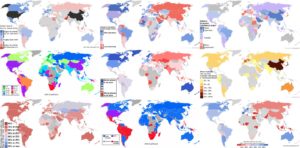You’ve probably had the following experience: You are reading along when a map, shaded in a procession of pastels, interrupts the story. Your eyes travel first to your home country, then to the country where you spent a summer abroad, and then, finally, sweep around the map looking for the brightest or dimmest shades that mark a place is the most or least of something. Along the way you cross a vast colorless expanse where Central Africa should be. “No data,” the legend explains.
This gap appears across a huge range of subjects that have inadequate source data for developing countries. Often, all of Sub-Saharan Africa is missing, but it is the Central African countries that seem to disappear most frequently. Central Africa is defined by the U.N. to include nine countries. It extends from the tiny island nation of São Tomé & Príncipe to the expansive, resource-wealthy Democratic Republic of the Congo. Estimates — and they are only estimates — put Central Africa’s total population at just under 150 million people.
The gap is a pervasive problem. In a 2013 Washington Post article titled “40 Maps that Explain the World,” at least half of the maps that included Africa were missing one or more Central African countries. Of those, many were missing data for the entire region. Somehow it is common to “explain the world” while saying little about a populated area nearly the size of Australia. In addition to perpetuating the historical bias of minimizing Africa on maps, this lack of information is indicative of many of the challenges these countries face.
El Iza Mohamedou is deputy secretariat manager for PARIS21, one of the most important initiatives to improve statistical capacity in developing countries. Speaking on her own behalf, she told Quartz that a lack of vital statistics makes it impossible to adequately monitor issues like poverty and maternal health — or to evaluate the success of policies aimed at improving them.
“Countries with the least satisfactory data on deaths and births, and whose maternal mortality rates have to rely on estimation, are exactly the ones where the maternal mortality problem is the severest,” she said.
Read more at www.qz.com



